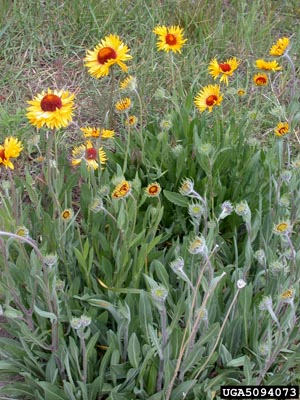Blanketflower

Common Name(s):
Blanketflower
Scientific Name:
Gaillardia species Foug.
Scientific Name Synonyms:
None Known
Symbol:
GAILL
Description:
Life Span: Annual and Perennial
Origin: Native
Growth Characteristics: Blanketflower has an inflorescence which resembles the brightly patterned blankets of Native Americans. It grows 1 - 3 feet tall, and will often grow in mounds 8 – 18 inches high. It flowers June – October.
Flowers: Bright daisy-like single color and bi-color blooms in shades from buff to red to brown. Flowers of certain species can be 4 inches wide. The ray petals have serrated tips – usually 3-toothed. Some varieties have a fringed look. The base of the flower (pappus) consists of several scales with awns.
Fruits/Seeds: Similar to a sunflower seed, smaller and at least partly covered with long hairs
Leaves: Leaves are basal and are lance to linear shaped. Leaves have a hairy texture, and can have margins which are smooth, toothed, or lobed.
Stems: Wiry, branched stems, mostly without leaves
Ecological Adaptions:
Found on the dry slopes and meadows of uplands and mountains. It is drought tolerant and capable of growing under very harsh conditions. It prefers full sun.
Soils: Dry, well drained.
Uses and Management:
Not a highly grazed species. When grazed, it is most often grazed during the early part of the season.
It is often cultivated and grown in flower beds.

